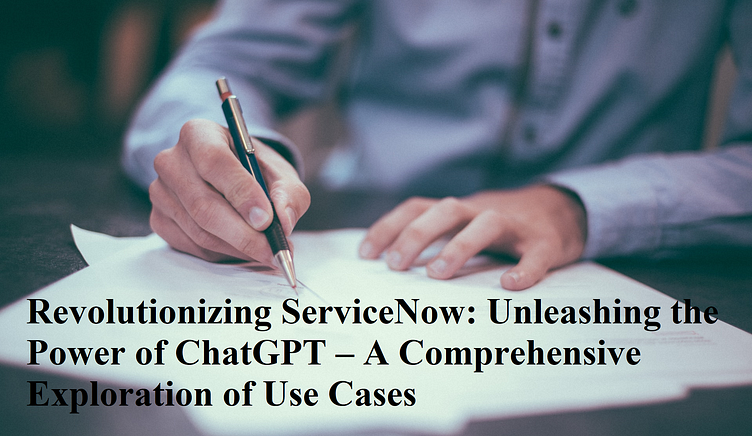Revolutionizing ServiceNow: Unleashing the Power of ChatGPT
In the ever-evolving landscape of IT service management, organizations are continually seeking innovative solutions to enhance efficiency, user experience, and overall productivity. The integration of ServiceNow, a leading platform for IT service management, with ChatGPT, powered by OpenAI's GPT-3.5 architecture, marks a paradigm shift in how businesses approach communication and support. This comprehensive guide explores the myriad use cases where ServiceNow and ChatGPT converge, ushering in a new era of intelligent and user-centric IT service delivery.
Understanding ServiceNow and ChatGPT
ServiceNow is a cloud-based platform that streamlines IT service management (ITSM) and automates various business processes. From incident management to service catalog optimization, ServiceNow provides a comprehensive suite of tools to enhance the efficiency and effectiveness of IT services within an organization.
ChatGPT, developed by OpenAI, represents a breakthrough in natural language processing (NLP). It is powered by the GPT-3.5 architecture, allowing it to understand and generate human-like text. This makes ChatGPT an ideal candidate for enhancing conversational interfaces and automating interactions in various applications.
Use Case 1: Intelligent IT Service Desk
a. Automated Ticketing and Incident Resolution: By integrating ChatGPT with ServiceNow's ITSM capabilities, organizations can implement an intelligent IT service desk. ChatGPT can automate the creation of incident tickets based on user queries and even provide initial troubleshooting steps, expediting the incident resolution process.
b. User-Friendly Self-Service Portals: ServiceNow's self-service portals can be enhanced with ChatGPT to provide users with a conversational interface. Users can submit requests, report issues, and seek information in a natural language format, making the self-service experience more intuitive and user-friendly.
Use Case 2: Knowledge Base Enrichment
a. Dynamic Knowledge Base Updates: ChatGPT can be leveraged to enrich ServiceNow's knowledge base dynamically. By analyzing user interactions and feedback, ChatGPT can suggest updates to knowledge articles, ensuring that the information remains relevant and up-to-date.
b. Automated Documentation Generation: ServiceNow administrators often need to update documentation. ChatGPT can assist in automating the generation of documentation by understanding and responding to queries related to system configurations, workflows, and best practices.
Use Case 3: Streamlining Change Management
a. Change Request Assistance: Integrating ChatGPT with ServiceNow's change management module can streamline the process of submitting change requests. ChatGPT can guide users through the necessary steps, ensuring that change requests are submitted with the required information and documentation.
b. Change Impact Analysis: ChatGPT's analytical capabilities can be harnessed to perform change impact analysis. By processing data and understanding dependencies, ChatGPT can assist in assessing the potential impact of proposed changes, aiding decision-making in change management processes.
Use Case 4: Intelligent Automation and Orchestration
a. Workflow Automation: ServiceNow workflows can benefit from the intelligent automation capabilities of ChatGPT. ChatGPT can analyze workflow queries, suggest optimizations, and even automate routine tasks within the workflows, enhancing overall efficiency.
b. Orchestration of IT Processes: ChatGPT can serve as an orchestrator for various IT processes within ServiceNow. This includes automating complex tasks, coordinating activities between different modules, and ensuring seamless communication between systems.
Use Case 5: Enhancing User Training and Onboarding
a. Interactive User Training: ChatGPT can play a role in user training and onboarding within the ServiceNow environment. By providing interactive and conversational guidance, ChatGPT can help users familiarize themselves with ServiceNow features, functionalities, and best practices.
b. Context-Aware Onboarding Support: During onboarding processes, ChatGPT can assist new users by providing context-aware support. This includes answering queries, guiding users through setup procedures, and ensuring a smooth transition into using ServiceNow's capabilities.
Case Studies: Real-World Success Stories
a. Case Study 1: Global IT Service Desk Transformation: A multinational corporation implemented ChatGPT in conjunction with ServiceNow to transform its IT service desk. The integration led to a significant reduction in response times, increased user satisfaction, and improved incident resolution rates.
b. Case Study 2: Automated Change Management Excellence: A large enterprise optimized its change management processes by incorporating ChatGPT into ServiceNow. The intelligent automation provided by ChatGPT streamlined change request submissions, minimized errors, and improved overall change management efficiency.
Best Practices for ServiceNow and ChatGPT Integration
a. User-Centric Design: Prioritize a user-centric design when implementing ChatGPT with ServiceNow. Ensure that the conversational interfaces align with user expectations, making interactions intuitive and enjoyable.
b. Continuous Training and Optimization: Regularly train and optimize the ChatGPT model based on user interactions and feedback. This ensures that the model evolves with changing user needs and remains aligned with the organization's goals.
c. Security and Compliance: Adhere to security and compliance standards when implementing ChatGPT with ServiceNow. Consider encryption, access controls, and data privacy to safeguard sensitive information processed during interactions.
Future Trends: ServiceNow and ChatGPT
a. Advanced Natural Language Understanding: Future trends may see the integration of advanced natural language understanding capabilities into ChatGPT, further enhancing its ability to comprehend and respond to intricate user queries within the ServiceNow environment.
b. Multimodal Capabilities: As both ServiceNow and ChatGPT evolve, future integration may extend beyond text-based interactions. Multimodal capabilities, incorporating images, audio, and video, could redefine how users interact with ServiceNow through ChatGPT.
c. Integration with Emerging Technologies: The future may witness the integration of ChatGPT with emerging technologies such as augmented reality (AR) and virtual reality (VR). This could redefine how users visualize and interact with ServiceNow data and workflows.
Conclusion
In conclusion, the integration of ChatGPT with ServiceNow marks a revolutionary step in reshaping how organizations approach IT service management. From intelligent service desks to streamlined change management, the use cases are diverse and transformative. As businesses navigate the complexities of implementation, they have the opportunity to create more efficient, user-friendly, and intelligent IT service ecosystems. The synergy between ServiceNow ChatGPT use cases represents a powerful union of cutting-edge technologies, paving the way for a future where IT services are not just managed but intelligently orchestrated for maximum impact.
